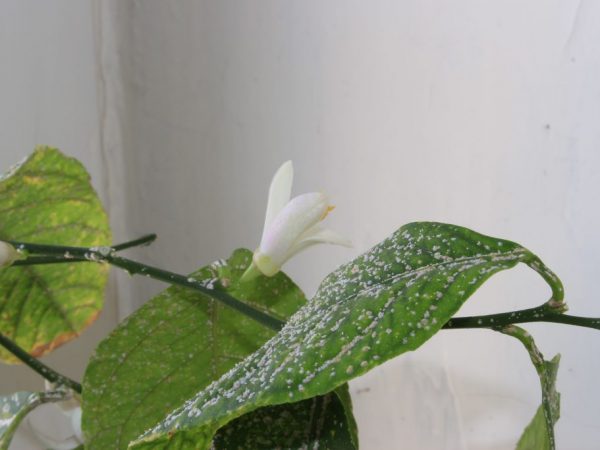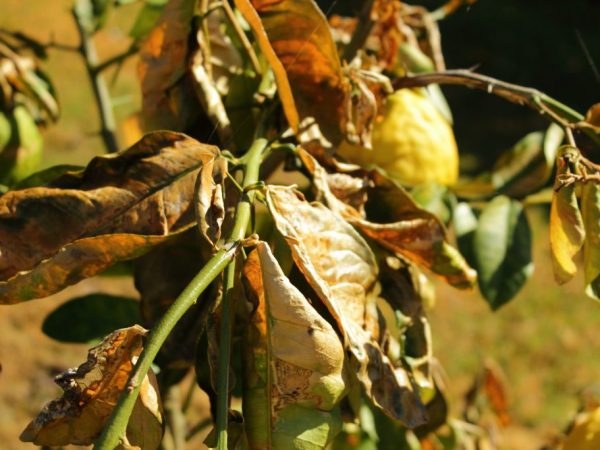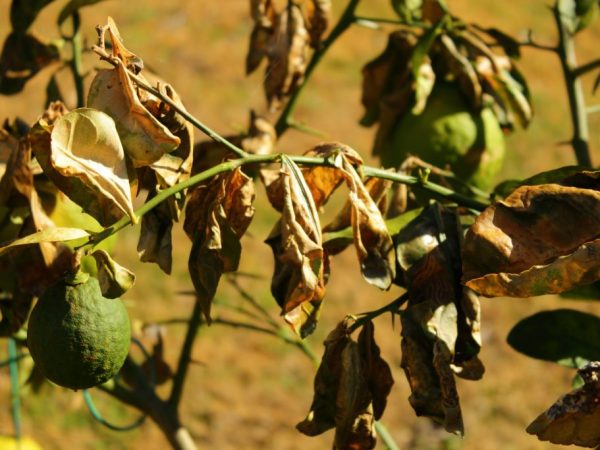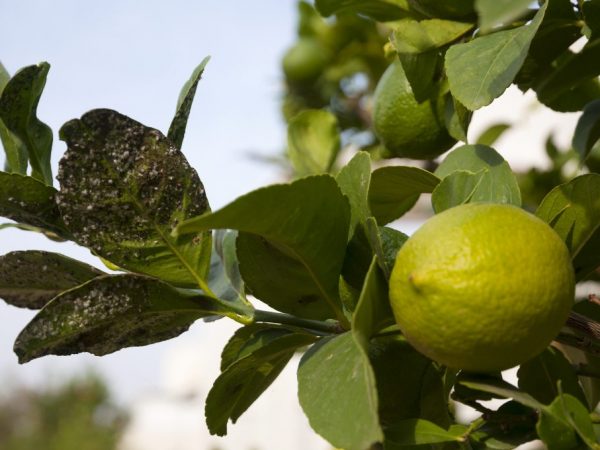Indoor lemon pests and diseases
In the process of growing indoor lemon, flower growers often encounter its diseases and pests. The affected citrus tree loses its decorative appearance, ceases to bloom, bear fruit, and often dies. Knowing the root causes of lemon disease and treating them at home can help you avoid growing difficulties.

Indoor lemon pests and diseases
Why does lemon get sick
This exotic plant is affected by diseases and pests in the following cases:
- in the process of grafting with a diseased cutting;
- improper care: planting in contaminated soil, too frequent or rare watering, insufficient lighting, illiterate pruning or insufficient soil fertilization;
- the plant did not have time to get stronger after a previous illness;
- infection of healthy domestic specimens with street ones;
- the ingress of bacteria, viruses and fungi into the room during ventilation;
- making mistakes in the process of breeding, planting and transplanting.
Classification of diseases
Diseases of indoor lemon are divided into 2 groups:
- viral;
- fungal.
For each disease, a specific treatment regimen is used with the use of special drugs.
Viral
Diseases of indoor lemons caused by viruses lead to massive loss of leaves on the tree. After such sores, the plant becomes completely bare, often dying. It is advisable for beginner flower growers to familiarize themselves with their description and methods of struggle.
Sheet mosaic
Dark and light streaks appear on the leaves of the affected specimen, resembling a mosaic in appearance. Over time, they become pale or completely white, lose their shape. Young lemon leaves develop misshapen. With a leaf mosaic, the tree stops growing.
If a lemon gets sick with this disease, it is quarantined, away from healthy specimens. It is impossible to completely get rid of the leaf mosaic, since at the moment there are no drugs for this sore. All you can do is to alleviate the symptoms of its course by providing proper care, and above all, a balanced and regular feeding. Severely affected specimens must be destroyed.
Citrus Cancer
This disease on lemon leaves looks like brown spots. It is also characterized by the appearance of brown spots on the fruit. With a prolonged course of the disease, young lemon leaves are deformed and take on an ugly shape. The fruit shrivels and does not develop. Over time, such a specimen dies.
Treatment of this disease of home lemons is impossible, therefore, in order to prevent it, preventive measures are taken: treatment in the spring with liquid copper fungicides.
Tristeza

The infected tree can no longer be saved
The first sign that tristeza has appeared on a houseplant is massive foliage. Further, the bark and shoots die off, which are covered with brown spots.A specimen infected with tristeza cannot be treated and quickly dies.
Most often, lemons get sick with viral infections, subject to illiterate care and during a period of weakened immunity.
Fungal and infectious
Damage to lemons by fungus or infection at home is not uncommon. The reasons are the same as for infection with viral diseases.
Gomoz
The presence of elongated brown spots on the branches and trunk are the first signs of homoz. The bark under such spots quickly dies off and begins to crack. In places of cracks, a sticky, golden-colored substance is formed, which quickly hardens.
The main reasons for the development of home lemon disease are mechanical damage to the bark (fractures, cracks), high air humidity in the room, a lack of phosphorus-potassium fertilizers in the soil, an excess of nitrogen, planting in already infected soil, or too deep burial of the trunk.
It is worth treating a sick specimen in the following way: remove the infected bark on the trunk, cut off heavily affected shoots. Treat the stripping and trimming areas with any fungicide of 3% concentration and cover with garden varnish.
The duration of treatment will depend on the degree of damage to the tree. The treatment is carried out until brown spots no longer form.
Anthracnose
Of all diseases, indoor lemons are most often affected by anthracnose. It is determined that this sore appears on the lemon by the leaves: they fall off en masse. But first, the leaf plate turns white or yellow. Flower buds also fall. The fruits are covered with reddish spots.
Control measures include removing dead branches and infected leaves. Three times treatment of the affected specimen with the drug "Fitosporin". Another option is to treat the tree with a 1% solution of Bordeaux mixture.
Scab
Scab is another dangerous disease of indoor lemons. Young foliage is covered with yellow spots, which after a while transform into pink-gray growths. Leaves on which such a plaque appears will die off. The fungus continues to parasitize, spreading to leaf petioles and nearby shoots. The appearance of this sore is also evidenced by orange spots on the skin of the fruit. After a while, they darken and turn dark red. At an advanced stage, blackening is noticeable in the affected areas.
They begin to treat the tree by spraying with a 1% Bordeaux mixture. All affected parts on the crown are preliminarily removed.
Melseco

All affected trees must be destroyed
When melseco is infected, the branches of the tree at the tips begin to dry out, the leaves crumble en masse. On the cuts, the branches acquire a reddish tint.
The reason is improper care, or rather, lack of light in the winter. There is no point in fighting this disease, since all methods are useless. The only thing that is required of this is regular examination of the tree for symptoms.
Affected specimens are subject to destruction.
Root rot
Often, indoor lemons have leaves that fall off. When 1-2 leaves fall off, you should not worry: this is a natural process. In case of massive leaf fall, it is worth digging up a tree and examining its root system.
If the roots are dark, moldy, and soft to the touch, the tree is affected by root rot. All decayed parts are cut off with a sterile knife or pruner. Places of cuts are powdered with crushed charcoal. Next, a transplant is carried out into a new flowerpot.
The transplanted lemon is placed in a well-lit place with protection from the scorching sun. Watering is allowed only a week after transplanting to prevent re-rotting of the root system.
Pests
In addition to fungal and viral diseases, there are various pests of indoor lemon.
Shield
Sticky leaves on a lemon are the first sign of a scabbard attack. This parasite in appearance resembles microscopic bumps on the surface of shoots and foliage.Females settle on the underside of the leaf plate. From the eggs laid on the underside of the leaf, larvae hatch, which spread over its entire surface. The affected specimen with a sticky coating becomes weak, quickly withers and is susceptible to infection with a number of diseases.
Homemade lemon diseases are treated with insecticides or soapy water. For 1 liter of water, 2 tbsp is consumed. l. any liquid soap. All parts that bulge are processed.
After processing, the tree is washed under the shower. After 2-3 days, the treatment procedure is repeated.
Common aphid
The mass appearance of light green aphids is noticeable on young shoots. The green, succulent branches have not yet barked and are excellent food for parasites. Pests first infect the lower part of the leaf plate, then move to its upper part, sucking the juices from the tissues. As a result, homemade lemon leaves curl and dry out. Sticky droplets appear in the affected areas. Such a plaque serves as the basis for the development of a sooty fungus - a dangerous disease that leads to death.

Cut off the tops along with the insects
With a minor lesion, they are dispensed with by cutting off the affected parts along with insects. If the aphid has spread to the whole plant, the crown is treated with garlic infusion (4 peeled and chopped garlic heads are infused in 5 liters of water for a day). Also, insecticides are used to treat infected specimens.
Root aphid
Unlike the previous pest, this harmful insect parasitizes in the soil, affecting the delicate root system.
Notice how this pest appears is obtained by the appearance of the plant. It becomes lethargic, stops growing, the leaves become drooping and turn yellow.
Such a tree is removed from the pot, its roots are sprayed with a contact insecticide or a weak garlic infusion, and then transplanted into a new container, having previously sterilized the planting soil.
Spider mite
Often a spider mite appears on a lemon. These lemon pests appear in dry conditions and low indoor humidity. They affect young leaves and twigs. The appearance of a small web on a lemon indicates the spread of the mite.
The tick is destroyed at home using a four-fold treatment with 1% boric acid solution. The interval between treatments is 5 days.
If a lemon infects a spider mite, the humidity level in the room is increased and frequent irrigation of the aerial part is carried out.
Preventive measures
To prevent the appearance of diseases and pests on this exotic plant, the gardener requires not only compliance with agrotechnical rules, but also the provision of competent care. First of all, such measures should be aimed at increasing the immunity of the plant and its resistance to infection.
It is possible to prevent chlorosis (imbalance in the distribution of chlorophyll), to activate the growth and development of a plant, using the following composition in the diet of a house tree:
- ammonium nitrate - 15 g;
- iron vitriol - 3 g;
- boric acid - 5 g;
- potassium sulfate - 15 g.
The dry mixture is dissolved in 10 l of water. Lemons are watered with a nutrient solution no more than once every 5 months.
This composition protects indoor citrus fruits from fungal, viral and infectious diseases. It gently stimulates the healthy development of plants.
In the process of growing lemon, it is important:
- regularly check for diseases and parasites;
- to provide the culture with timely care and the necessary conditions of detention;
- carry out regular moistening of the crown: irrigate every day, take a shower once a month;
- every month, for the purpose of disinfection, treat the crown with soapy foam.
Conclusion
Despite the fact that the citrus tree is susceptible to many diseases and pests, it is not difficult to prevent their occurrence.It is only necessary to observe preventive measures, to show attention and care in relation to the plant, and then it will thank you with a healthy and decorative look.

